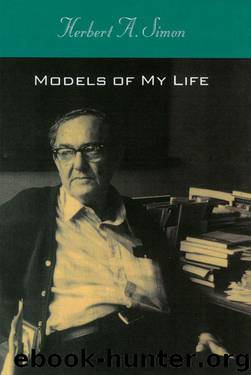Models of My Life by Herbert A. Simon

Author:Herbert A. Simon [Simon, Herbert A.]
Language: eng
Format: epub, azw3
Tags: Biography & Autobiography, Science & Technology
ISBN: 9780262691857
Google: dFgwBQAAQBAJ
Amazon: 026269185X
Publisher: MIT Press
Published: 1996-10-08T00:00:00+00:00
THE THIRD PANEL
View from the Mountain
CHAPTER 14
Exploring the Plain
THE mountain pass over which Al, Cliff, and I crossed with the realization of the Logic Theorist opened up vast views. We saw before us the whole domain of artificial intelligence and the whole domain of human cognition. Numerous scientists have shared with us the adventure of exploring these lands, both at Carnegie and at many other institutions. This chapter recounts some of the explorations of our own research group, at first the three of us, soon a growing circle of graduate students and faculty colleagues, during the years from 1956 to 1978.
No detailed master plan mapped our research from the initial success of LT through the 1970s. We followed something like the flexible tactics advocated by the British military expert Liddell Hart, and gratefully borrowed by the Germans for the 1940 blitzkrieg: Push across the front; when you find a soft spot, wherever it may be, pour your reserves through and keep going. Research, groping through the uncertain and the unforeseeable, must be flexible to grasp and exploit every sign of progress. Let me try to describe how we carried out that strategy.
THE RESEARCH STRATEGY
The initial motives that led us to the Logic Theorist, in the GSIA environment, influenced our research strategy. We were interested both in business applications that exploited the newfound powers of computers for symbolic processing, and in extensions that would contribute to understanding human thinking. Nowadays, we usually call the former artificial intelligence and the latter cognitive science. Along both fronts, our strategy was to select promising tasks that call for intelligence and to write and test programs capable of handling them. In the cognitive science part of our research, we also ran experiments with human subjects doing the same tasks to see how closely the computer simulations paralleled human behavior. As we gained a reasonable understanding of each task, we moved on to another. The precise order in which we took up tasks was partly a matter of chance, although we tended to start with those that seemed simple and progress toward the more complex. Eventually, we wanted to model the whole (cognitive) human being—a goal that would keep us busy indefinitely.
The artificial intelligence side was the easier to relate to the goals of a business school. Among the graduate students, Fred Tonge was soon building a program that used heuristic search to balance assembly lines (to find the best arrangement of workers, tasks, and work stations), while Geoffrey Clarkson constructed an expert system (as we would call it today) for choosing stock portfolios for bank trust accounts. There was no deep reason for selecting these two particular tasks: they just came to attention, were practically and theoretically interesting, and seemed doable. Doability and significance are always good bases for choosing research problems. We want a problem whose answer has interest and value, but only if we have some ideas for approaching it.
The significance of a problem for cognitive science could be judged by how much attention psychologists paid to it and whether it illuminated important human capabilities.
Download
This site does not store any files on its server. We only index and link to content provided by other sites. Please contact the content providers to delete copyright contents if any and email us, we'll remove relevant links or contents immediately.
Algorithms of the Intelligent Web by Haralambos Marmanis;Dmitry Babenko(8519)
Test-Driven Development with Java by Alan Mellor(7355)
Data Augmentation with Python by Duc Haba(7253)
Principles of Data Fabric by Sonia Mezzetta(6998)
Learn Blender Simulations the Right Way by Stephen Pearson(6935)
Microservices with Spring Boot 3 and Spring Cloud by Magnus Larsson(6766)
RPA Solution Architect's Handbook by Sachin Sahgal(6170)
Hadoop in Practice by Alex Holmes(6028)
The Infinite Retina by Robert Scoble Irena Cronin(5870)
Jquery UI in Action : Master the concepts Of Jquery UI: A Step By Step Approach by ANMOL GOYAL(5869)
Big Data Analysis with Python by Ivan Marin(5694)
Life 3.0: Being Human in the Age of Artificial Intelligence by Tegmark Max(5398)
Pretrain Vision and Large Language Models in Python by Emily Webber(4654)
Infrastructure as Code for Beginners by Russ McKendrick(4439)
WordPress Plugin Development Cookbook by Yannick Lefebvre(4168)
Functional Programming in JavaScript by Mantyla Dan(4121)
The Age of Surveillance Capitalism by Shoshana Zuboff(4111)
Embracing Microservices Design by Ovais Mehboob Ahmed Khan Nabil Siddiqui and Timothy Oleson(3959)
Applied Machine Learning for Healthcare and Life Sciences Using AWS by Ujjwal Ratan(3931)
